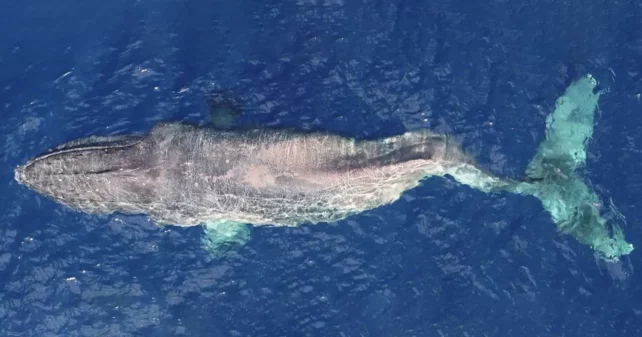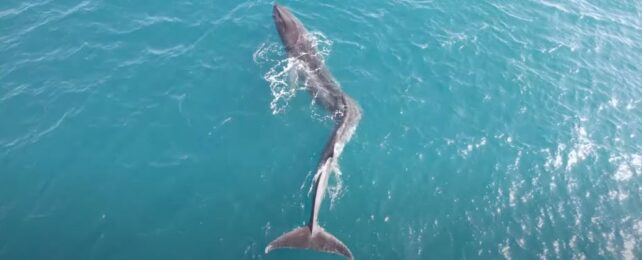A massive 40-ton fin whale swimming off the coast of Valencia in Spain has been filmed with a severe bend in its 17-meter-long body (56 feet) in what appears to be a pronounced case of scoliosis.
At first, when the skipper of a local boat caught sight of the poor creature from afar, it seemed to be struggling to swim, as though caught in the web of a fishing net.
Once biologists and veterinarians arrived on the scene it became clear the whale's condition wasn't quite what they expected, with drone footage revealing a sharp deviation in the animal's spine about halfway down its body.
The fin whale's disorder looked so severe, it seemed to have thrown off its entire anatomy, according to a Facebook post from the Oceanografic Foundation in Valencia (Fundación Oceanogràfic de València), which sent the rescue team.
Biologists were hoping to attach a tracker to the whale, but the malformation in its spine made that impossible.
After a few hours, the fin whale left the coastline, swimming with difficulty.
Scoliosis among whales is rare, but when it does occur, it tends to draw our attention.
In 2019, a minke whale with a clear curve in the spine was tragically found washed ashore, allowing researchers the chance to study the anatomical impact of scoliosis in whales up close.
Their findings suggest a shared mechanical basis for scoliosis in humans and in whales. Humans can sympathize with the painful condition more than any other mammal. We are the only species known to spontaneously develop scoliosis without any obvious underlying cause, what is termed 'idiopathic' scoliosis.
Our anatomy reduces rotational stability to distribute weight more easily for bipedal movement, which means our spines can bend out of shape relatively easily without any obvious cause.
Whale anatomy, on the other hand, provides these marine giants with vertebral columns that are less prone to bending out of shape under the strain of posture and usage than our upright spines.
In the case of the fin whale from Valencia, it's unclear how its spine got to be so deformed. With global shipping traffic on the rise the chance of an encounter with a powerful ocean vessel could explain its condition.
Estimates suggest up to 20,000 whales die from collisions with vessels globally each year, and most of these collisions involve fin whales, the second largest mammal in the world and one that spends quite a bit of time near the surface of the ocean. Humpback whales are the next most common victim.
Just last year, a humpback whale with a broken back was tracked by drone cameras as it swam all the way from northern British Columbia to Hawaii.

"The harrowing images of her twisted body stirred us all. She was likely in considerable pain yet she migrated thousands of miles without being able to propel herself with her tail," reads a press release, published by BC Whales on Facebook at the time.
"Her journey left her completely emaciated and covered in whale lice as testament to her severely depreciated condition. This is the stark reality of a vessel strike, and it speaks to the extended suffering that whales can endure afterwards. It also speaks to their instinct and culture: the lengths whales will go to follow patterns of behavior."
While injury could be the cause, congenital abnormalities of this kind in whales aren't unknown.
In 2005, for instance, an orca in British Columbia was reportedly born with scoliosis, impacting his ability to swim and hunt. His pod seemed to pull back on the speed and length of their escapades to account for the whale's reduced speed and endurance. The underlying reason for the creature's congenital abnormality is unknown, but sadly, he died relatively young.
A similar congenital abnormality can also impact dolphins. In fact, a bottlenose dolphin with scoliosis was filmed a decade ago swimming along with sperm whales, as though it had been adopted by the pod.
Moments like these are a cruel reminder that even when cetaceans aren't killed by ship collisions, the consequences are lifelong.
